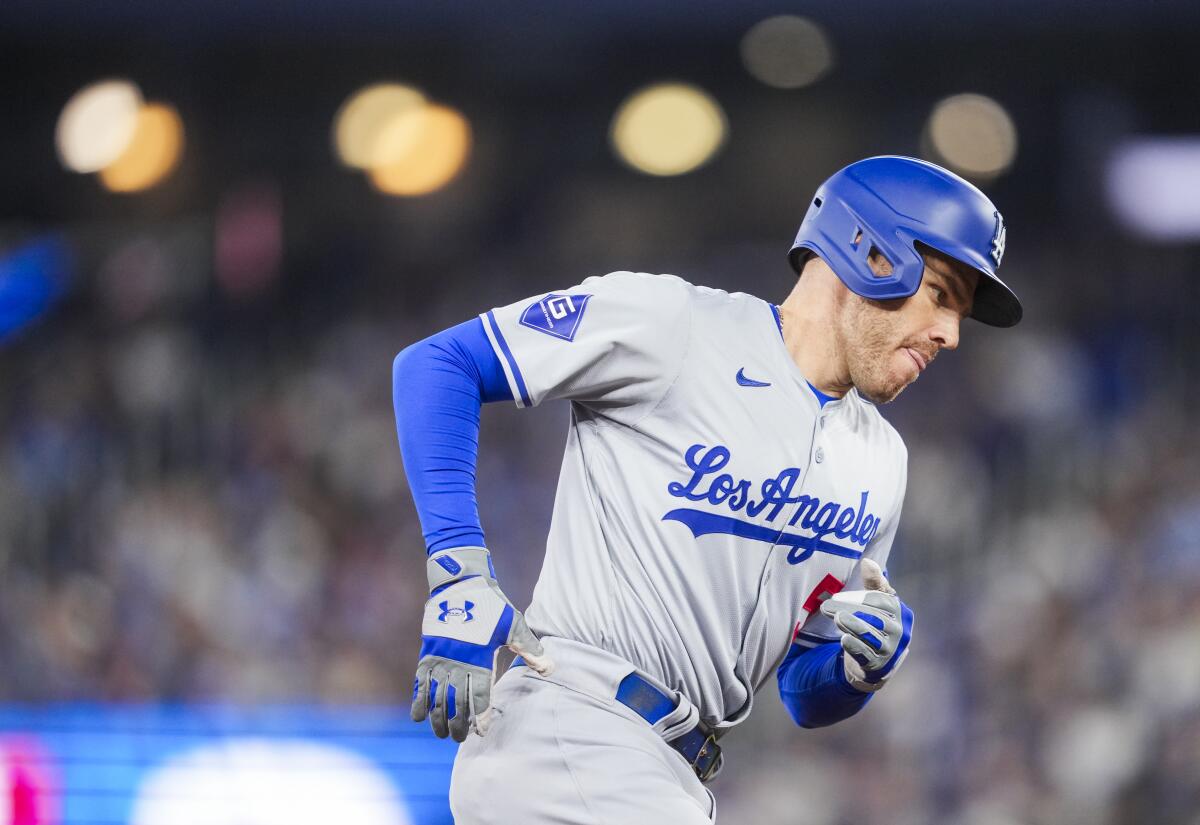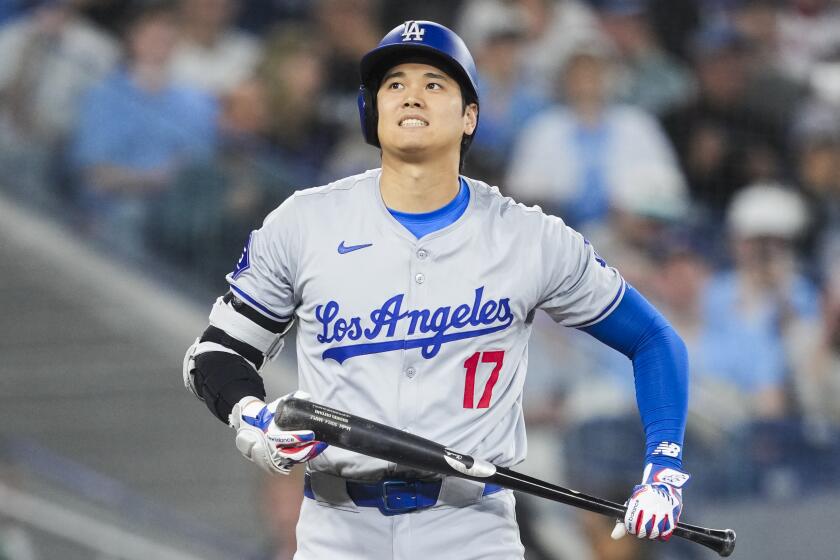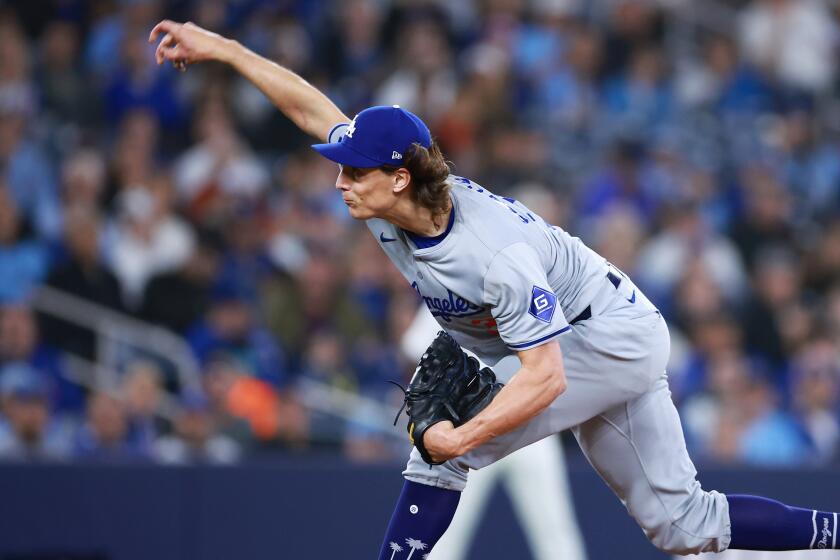How Freddie Freeman — now back on a hitting streak — worked through early-season slump

PHOENIX — On the surface, it might not have looked like much of a slump.
To star Dodgers slugger Freddie Freeman, however, his performance through much of April was certainly starting to feel like one.
Entering play Monday, Freeman was batting .306 with eight doubles, two home runs and 19 RBIs. He had a .861 on-base-plus-slugging percentage and 142 OPS+ (meaning, essentially, he has been 42% more productive than the average MLB hitter).
Those were drops from his first two seasons in L.A., in which he finished top-five in MVP voting both times.
But a slump? Really?
The Dodgers had a chance to extend their winning streak when two reached safely with no outs in eighth inning but fail to deliver in clutch against Blue Jays.
“I take pride in being consistent,” Freeman said. “And I’m not being consistent right now.”
That, at least, was what Freeman was feeling two weeks ago, in the midst of an eight-for-47 stretch that dropped his batting average to .259.
“I’m not hitting the pitches I’d normally hit,” Freeman said then. “There’s a lot going on up there. Trying to figure it out.”
There are points in every season where Freeman cools off, and his precise swing mechanics get out of whack. Almost always, it’s because his hips rotate too open, and his bat cuts short and across the strike zone — not square and straight through it.
The result: Freeman will stop hitting fastballs for opposite-field line drives, or barrel up breaking pitches into the right-center field gap. Instead, he will hit lazy pop-flys, or yank a ground ball to the pull side, or simply foul off mistake pitches he’d typically clobber.
“I’m not swinging at bad pitches,” Freeman said, at the height of his early-season struggles. “I’m just not hitting them where they should be going.”
The fix: A curated routine of slump-busting pregame techniques; especially a signature “net drill” in which Freeman will set up about an arm’s distance from a batting screen, then try to execute a swing without brushing the barrel against, hoping to recalibrate the inside-out bat path that has long been key to his career .301 batting average.
“I usually only bring it out 5-10 times per year,” Freeman said of the drill, which he has been doing since he was a kid. “That’s usually when things are really off.”
This year, Freeman dusted it off early, one of several notable alterations he has made to his meticulous pregame process.
In recent weeks, the 34-year-old has also started taking almost daily rounds of outdoor batting practice, a rarity during his first two years with the Dodgers (he typically prefers to hit in the clubhouse batting cages).
Overall, he has increased his total amount of pregame swings three-fold, he said, “just to hurry this [process] up.”
Lately, at last, better results have started to follow.
Freeman entered Monday on an eight-game hitting streak, going 12 for his last 27 with 11 RBIs and more extra-base hits (five) than strikeouts (four).
Half of those games have been multi-hits efforts. And in all but one, he has recorded a hit either up the middle or the other way — a telltale sign of synced-up mechanics in his swing.
“Everything’s kind of been working,” Freeman said. “Just been kind of doing really really slow, soft swings in BP, and then let the adrenaline of the game take the swing a little bit harder. Things the last week have been a lot better.”
It’s a welcome sight for the Dodgers, who haven’t often seen their $162 million first baseman struggle since arriving in March 2022.
“He’s gonna come out of it,” manager Dave Roberts said this weekend. “But there’s some sadness when he’s in a dark place.”
Phrases like “sadness” and “dark place” might not square with Freeman’s actual numbers.
Even at his recent low point, when a three-game hitting drought culminated with a three-strikeout performance on April 19, Freeman’s production was still comfortably above league average.
Even as he battled inconsistency at the plate, he still wore a perpetual smile, joking around with coaches and teammates.
“Sometimes players are in a dark spot and they really feel it and mean it,” Roberts said. “But Freddie knows he’s a great hitter … So I think he has some levity with it.”
Indeed, when asked last week if he was being superstitious by changing his hitting routine, Freeman referenced a line from Steve Carell’s character in “The Office,” Michael Scott.
“Just a little stitious,” he responded.
When told, jokingly, this weekend, he must be the worst .300 hitter in baseball, Freeman chuckled and shrugged.
“Feels like it,” he said.
Still, the reason this slump felt different, why the frustration was boiling much closer to the surface, is because it came on the heels of similar struggles last fall.
At the end of the 2023 regular season, Freeman batted just .262 over his final 17 games (a notable drop from his .339 average before then). Then, in the Dodgers’ postseason sweep to the Arizona Diamondbacks, his swing seemed completely off, resulting in a one-for-10 mark that loomed large in the Dodgers’ early elimination.
“That’s why there has been so much frustration,” Freeman said earlier this month. “Because I know what I’m doing wrong. It’s over-rotation with my hips, which causes [other issues]. It’s the same thing every time. But for some reason, I’ve gone through everything about 20 times already and it hasn’t clicked yet. So that’s why, here I am, hitting outside, doing little things differently, [trying to] smile through it.”
Tyler Glasnow delivers six shutout innings before giving up a run and exiting the game because of cramping in the seventh inning of a 4-2 win over Toronto.
Finally, over the last week, it seems like the tide has started to turn.
In addition to his eight-game hitting streak, Freeman snapped another kind of drought on Sunday, hammering his first home run since the Dodgers’ home opener exactly a month earlier.
“No,” Freeman said when asked if he was worried about adding to his home run total, after it’d been stuck at one for 26 games. “If you’re just going for power when you don’t have a good swing already, it’s just never going to happen.”
But now, thanks to a laborious swing progression and trust in his hitting process, the moment offered the latest sign of Freeman’s continued turnaround; that an elongated (for him, at least) slump to start the season finally appears to be largely done.
“There’s still bad swings in there,” Freeman said, “but ultimately there have been a lot more good swings lately.”
More to Read
Are you a true-blue fan?
Get our Dodgers Dugout newsletter for insights, news and much more.
You may occasionally receive promotional content from the Los Angeles Times.










